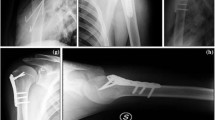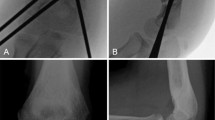Summary
Background
Fractures of the proximal humerus in children are rare and represent approximately 0.45 % of all paediatric fractures. These injuries are common in patients up to an age of 16 years. The treatment of displaced subcapital fractures is still controversially discussed in literature. Therefore the aim of this study was to evaluate the short-term outcome and to provide guidelines for surgical treatment of these fractures in children and adolescents.
Methods
Clinical and radiological results of 231 patients between 0 and 17 years with subcapital humerus fractures were evaluated. Patients were devided according to their treatment as followed (1) conservative treatment group (2) operative treatment group.
Results
A total of 191 patients (82.7 %) underwent conservative treatment and 40 (17.3 %) underwent operative treatment. Surgical treatment consisted of open reduction and internal fixation (ORIF) (35.0 %) or closed reduction and internal fixation (CRIF) (52.5 %). In all operated patients an axial deviation of more than 20 ° was observed preoperatively. According to our groups; the surgical group presented in 90 % (N = 36) of the patients with an excellent result, in 5 % (N = 2) an average result was observed and in 5 % (N = 2) a poor result according to Constant Murley Score was achieved. In the conservative treatment group in 185 patients (96.9 %) excellent results were achieved and in 6 patients (3.1 %) an average result in the Constant Murley Score was achieved.
Conclusion
Conservative treatment in children < 10 years and an angulation angle < 20 °, as well as surgical treatment with ORIF or CRIF in patients > 10 years and with an angulation angle > 20 ° leads to excellent short-term outcome. However, studies with longer observation time are needed to evaluate long-term complications like limb length discrepancy.




Similar content being viewed by others
References
Rose SH, Melton LJ III, Morrey BF, Ilstrup DM, Riggs BL. Epidemiologic features of humeral fractures. Clin Orthop Relat Res. 1982;168:24–30.
Schmittenbecher PP, Blum J, David S, Knorr P, Marzi I, Schlickewei W, et al. Treatment of humeral shaft and subcapital fractures in children. Consensus report of the child trauma section of the DGU. Unfallchirurg. 2004;107:8–14.
Baxter MP, Wiley JJ. Fractures of the proximal humeral epiphysis. Their influence on humeral growth. J Bone Joint Surg Br. 1986;68:570–3.
Dobbs MB, Luhmann SL, Gordon JE, Strecker WB, Schoenecker PL. Severely displaced proximal humeral epiphyseal fractures. J Pediatr Orthop. 2003;23:208–15.
David S, Kuhn C, Ekkernkamp A. Fracture of the proximal humerus in children and adolescents. The most overtreated fracture. Chirurg. 2006;77:827–34.
von Laer L, Kraus R, Linhart WE. Pediatric fractures and dislocations. Stuttgart: Thieme Medical; 2007.
Neer CS II, Horwitz BS. Fractures of the proximal humeral epiphysial plate. Clin Orthop Relat Res. 1965;41:24–31.
Bahrs C, Zipplies S, Ochs BG, Rether J, Oehm J, Eingartner C, et al. Proximal humeral fractures in children and adolescents. J Pediatr Orthop. 2009;29:238–42.
Lefevre Y, Journeau P, Angelliaume A, Bouty A, Dobremez E. Proximal humerus fractures in children and adolescents. Orthop Traumatol Surg Res. 2014;100:149–56.
Shrader MW. Proximal humerus and humeral shaft fractures in children. Hand Clin. 2007;23:431–5, vi.
Constant CR, Murley AH. A clinical method of functional assessment of the shoulder. Clin Orthop Relat Res. 1987;214:160–4.
Schwendenwein E, Hajdu S, Gaebler C, Stengg K, Vecsei V. Displaced fractures of the proximal humerus in children require open/closed reduction and internal fixation. Eur J Pediatr Surg. 2004;14:51–5.
Dameron TB Jr., Reibel DB. Fractures involving the proximal humeral epiphyseal plate. J Bone Joint Surg Am. 1969;51:289–97.
Arthurs OJ. Radiology of postnatal skeletal development: the proximal humerus. Skeletal Radiol. 2000;2:153–60.
Conflict of interest
The authors declare that there are no actual or potential conflicts of interest in relation to this article.
Author information
Authors and Affiliations
Corresponding author
Rights and permissions
About this article
Cite this article
Binder, H., Tiefenboeck, T., Payr, S. et al. Treatment of proximal humerus fractures in children and young adolescents. Wien Klin Wochenschr 128, 120–124 (2016). https://doi.org/10.1007/s00508-015-0879-3
Received:
Accepted:
Published:
Issue Date:
DOI: https://doi.org/10.1007/s00508-015-0879-3




